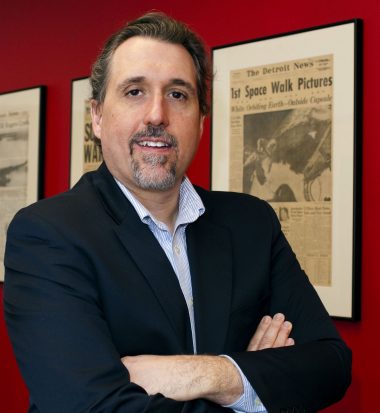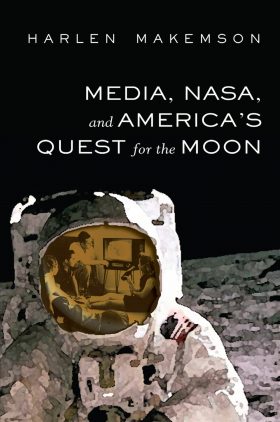ABC News journalist Jules Bergman filled the TV screen to give an update on the Apollo 13 space mission. Bergman had been covering the space program since before the Gemini missions, so he had become a signature personality in media coverage of lunar events. On this day, Bergman had bad news.
“Apollo 13 is apparently also losing breathing oxygen,” he said. “The emergency has ruled out any chance of a lunar landing and could endanger the lives of the astronauts themselves, if the (lunar module’s) oxygen supply plus whatever is left of the Command Module’s oxygen can’t last them until they can get back to Earth.”
Like millions of other Americans, associate professor of communications Harlen Makemson, author of the new book “Media, NASA, and America’s Quest for the Moon,” had a visceral reaction to the prospect that three American astronauts — James Lovell, Jack Swigert and Fred Haise — may not make it back to Earth.
“Apollo 13 is the one I remember,” said Makemson, who watched the coverage as a preschooler. “I remember crying like a baby when Jules Bergman said they may not come home.”
But they did come home, and Makemson’s encounter with media coverage of an Apollo mission stuck with him. “Media, NASA, and America’s Quest for the Moon,” published by Peter Lang Publishing and part of the Mediating American History series, which is edited by A.J. Fletcher Professor of Communications David Copeland, explores the dissemination of information about NASA’s lunar program on three fronts. And the book’s release (it’s available now) coincides with the 40th anniversary of the moon landing in July.
First, the book reveals how NASA struggled to provide the American public with wide open information, a charge that was mandated by Congress. Second, it focuses on the relationship between NASA and the press. Third, the book recounts the experience millions of Americans had watching space missions on television and reading about them in newspapers.

Makemson said NASA publically extolled the virtues of transparency, but internally, it grappled with what to release and what to withhold. He said up until the day before Alan Shephard’s first Mercury launch, NASA was still having discussions about what the public was going to see, if anything.
“How did we get from 1958 when all the launches were militarily closed and behind closed doors to the point where a nation’s watching as a rocket as big as an aircraft carrier is taking off to the moon?” Makemson said. “How did we get to that access? There were battles constantly over, yes, we’re going to release this, no, we’re not going to release this. What was the media going to have access to vis a vis the public? How is the public going to learn about the space missions?”
Makemson said there’s a long and widely held perception that the press gave NASA predominantly favorable coverage during its lunar launches through the 1950s and 1960s, and there’s some credence to that theory. But Makemson found the media weren’t always accommodating, such as in the aftermath of the Apollo 1 fire, when three astronauts died on the launch pad.
“There are definitely instances where you can find (positive coverage) but there are pockets of time throughout the ’60s were the media were critical,” he said. “They would ask, ‘Why are we throwing all these billions of dollars at this trip to the moon when we have all these problems here?’”
Just like the road to open information between NASA and the media had many twists and turns, so did Makemson’s eventual arrival at a topic for his first book. He said initially he planned on writing a book about iconic images from 1968, such as photographs depicting the Tet Execution (when General Nguyen Ngoc Loan executed a Viet Cong prisoner in Saigon) and Martin Luther King Jr.’s assassination, when he stumbled on a picture from the Apollo 8 mission.
“That got me thinking, ‘How did we get to see that in the first place? Who got to decide how that picture was taken?’” Makemson said. “There has to be a story here. No one’s done a book that looks at the ’60s space program from a pure information standpoint. The more I started reading, I realized there was an opportunity here. There was a story that hadn’t been told yet.”
Makemson began work on the book two years ago and used a sabbatical in the fall of 2008 to complete the writing process. Makemson gathered news footage of lunar missions from Vanderbilt University, studied the Walter Cronkite papers, sifted through the New York Herald-Tribune morgue files and read hours and hours of interviews completed by veteran journalist Robert Sherrod, who set out to write the definitive history of the Apollo program but died before he finished.
“I feel like I covered a lot of the ground I needed to cover as far as documentation and research,” he said. “I’m pleased with how it came together. I think it’s a compelling story. I think there’s enough in there where you can sort of picture what it would’ve been like.”
Makemson, entering his eighth year at Elon, teaches Editing and Design, Media Writing, Media History and, Design and Information Graphics in the School of Communications. He earned his Ph.D. from the University of North Carolina, his masters from the University of Missouri and his bachelor’s from the University of Kansas.
He has published extensively in media history journals and presented at media history conferences. Makemson also won the Excellence in Scholarship Award from the School of Communications in April.



